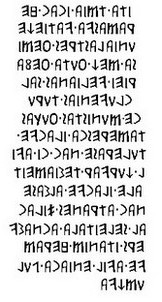Original Etruscan:

|
Transliteration:
ita.tmia.icac.he
ramasva.vatieKe
unial.astres.qemia
sa.meK.quta.qefa
riei.velianas.sal
cluvenias.turu
ce.munistas.quvas
tameresca.ilacve.
tulerase.nac.ci.avi
l.Kurvar.tesiameit
ale.ilacve.alsase
nac.atranes.zilac
al.seleitala.acnasv
ers.itanim.heram
ve.avil.eniaca.pul
umKva.
|
Rough Translation:
This temple and (this) statue have been dedicated to Uni / Astarte. Thefariei Velianas, head of the community, donated it for the worship of our peoples. This gift of this temple and sanctuary and the consecration of its boundaries during his three year term in the month of Xurvar(June?) in this way, and in Alsase (July?) this record together with the divinity/statue shall thus be buried by order of the Zilach that the years may outlast the stars.
|

















